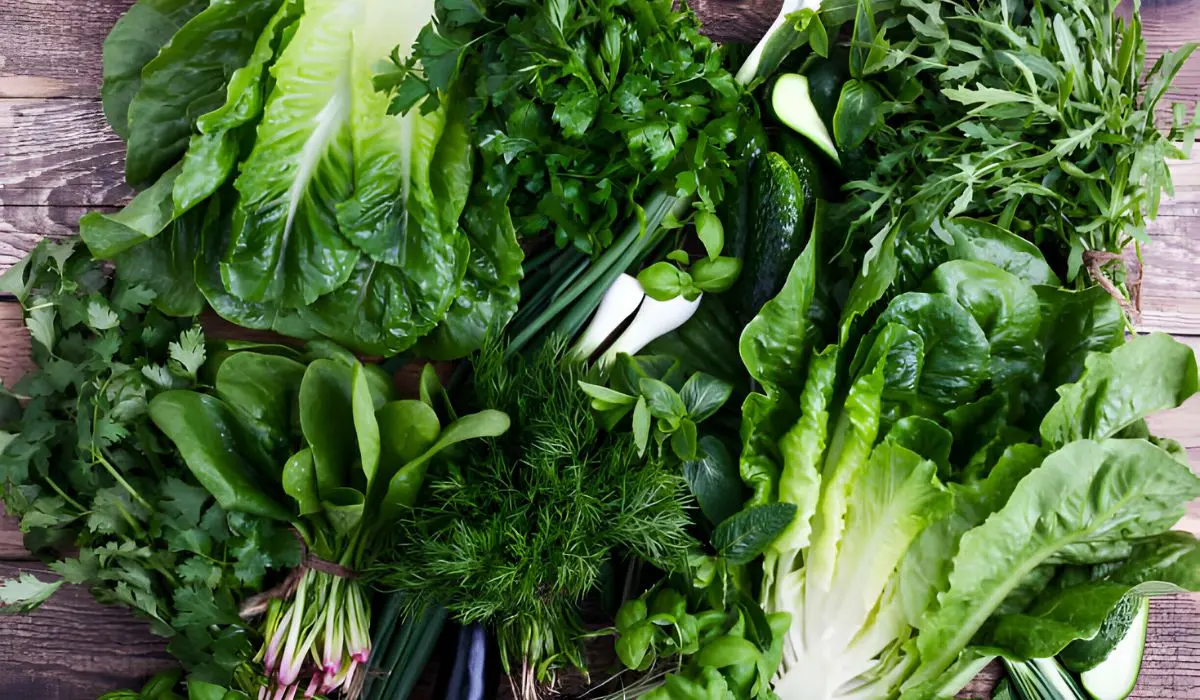Leafy green vegetables are one of the most important additions to a healthy diet. It is a great source of vitamins and minerals that are important for our health and well-being. Leafy greens are found to help support weight loss, reduce the risk of cardiovascular issues, improve blood pressure levels, and more.
There are nearly a thousand edible leafy green vegetables known to mankind. In this article, we will explore what are the 10 most beneficial leafy green vegetables for improving your health. We will also discover how much leafy greens you should add to your diet for optimal health. So, let’s begin this journey of understanding the true colors of leafy green vegetables.
What Are 10 Examples Of Leafy Vegetables?
Leafy green vegetables or simply leafy greens are edible leaves of a plant that are often eaten raw in a salad, or used in cooking. They are readily available in your local corner stores or supermarkets. Below is a list of 10 examples of leafy green vegetables:

1. Kale
Kale is a cruciferous vegetable that belongs to a group of cabbage cultivars. It is a highly nutritious vegetable that contains fiber, antioxidants, calcium, vitamins, iron, and many other nutrients that can help in achieving better health and reduce the risks of many health conditions. You can enjoy kale raw, cooked, or blended in smoothies.
2. Microgreens
Microgreens are young edible greens produced from various herbs, plants, and vegetables. They are usually used to add color, flavor, and texture to salads and wraps. Microgreen smoothies are also popular. They are nutrient-dense vegetables packed with vitamins C, E, and K. Some studies have also shown that microgreens are rich in phytochemicals that promote overall health and prevent diseases.
3. Collard Greens
It is a loose, slightly bitter-tasting edible leaf that belongs to the same family as kale, cabbage, and spring greens. They are an excellent source of calcium, potassium, and vitamins A, B9, C, and K. Collard greens can help with blood clotting, building bones, regulating LDL cholesterol levels, etc. You can add them to your rolls, pestos, sauces, and dips to give them a slightly bitter taste.
4. Spinach
Spinach is a good source of iron, vitamins c and E, potassium, and magnesium. Incorporating spinach into a healthy diet can support your immunity, improve digestive health, support red blood cell production, and more. It is a versatile leafy green that can be added to a variety of foods including soups, sauces, smoothies, and salads.
5. Arugula
Argula is a vegetable that belongs to the family of broccoli, kale, and cabbage. It is known for its peppery flavor that becomes more bitter as they age. They have antioxidant compounds that can reduce or reverse cell damage. It is also packed with glucosinolates that are shown to have anti-cancer properties. People usually add it to their salads or pizza toppings.
6. Cabbage
Cabbage is a vegetable that looks similar to lettuce. You can find a variety of cabbages that are different in their shape, texture, and colors. Cabbage is usually pickled, or fermented to be added to sauerkraut, kimchi, and coleslaw Raw cabbage is rich in dietary fiber, and vitamins K and C. It also contains glucosinolates that give it a slightly bitter flavor. Glucosinates are known for their anticancer properties.
7. Beet Greens
As the name suggests, beet greens are edible green leaves from the beetroot plant. They are packed with nutrients such as iron, vitamins A, C, K, and dietary fiber. They contain certain antioxidants that can help prevent eye disorders such as macular degeneration and cataracts. You can find several recipes that include beet greens.
8. Bok Choy
Bok choy is a type of Chinese cabbage that is also known as pak chi or pok choi. Similar to mustard greens, bok choy also doesn’t form heads. It has a sweeter flavor than other leafy greens such as spinach with a slight peppery twist. It contains vitamins, minerals, antioxidants, and fiber that can have several health benefits such as promoting heart health, supporting thyroid function, and more.
9. Romaine Lettuce
Roman Lettuce is a type of lettuce that grows sturdy dark leaves head with firm ribs to that hold them together. Due to its crispiness, it has become one of the staples in salads and sandwiches. It contains high amounts of nutrients such as Vitamins C and K, folate, and minerals. It also is a good source of beta-carotene, which can support your vision, immunity, skin health, etc.
10. Mustard Greens
These peppery-flavored greens are rich in vitamins A, C, and K and other minerals. It contains a variety of phytonutrients and antioxidants which can defend against diseases, prevent cell damage, protect your skin, and lower the risk of diabetes. You can consume it raw or add it to your dishes.
Conclusion
Leafy greens are edible leaves of plants herbs and other vegetables. There is a wide variety of leaves and you can consume them raw, fermented, pickled, or cooked. Some of the top 10 leafy green vegetables include kale, microgreens, collard greens, spinach, arugula, cabbage, beet greens, bok choy, romaine lettuce, and mustard greens.
Incorporating leafy greens into a healthy and balanced diet can have many health benefits including improved immunity, blood pressure regulation, healthy heart functions, better vision, and many more. Remember to include a variety of leafy greens in your meals to reap these benefits.





